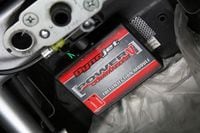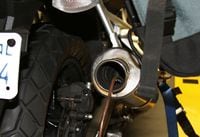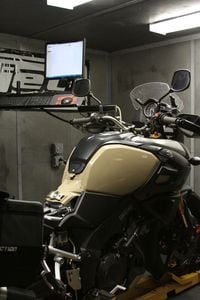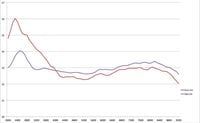WRIST: Marc Cook
MSRP (2014): $12,699
MILES: 14,701
MPG: 40
MODS: Nothing, unless you count a dozen or so Power Commander maps
I admit that one of my fetishes is trying to refine any bike's manners. Sometimes it's easy; a simple solution overcomes either a miscue on the part of the development team or, more likely, the side effects of meeting emissions regulations. The Suzuki V-Strom has been harder, mainly, I think, because the stock ECU is very, very sophisticated.
I started running the Power Commander V with the Holeshot Performance slip-on (see the Holeshot slip-on/PC5 update HERE). After a bit of refinement on a map meant for a different brand of slip-on, we managed to get a teeny bit more power to go with the Holeshot's totally civil yet throaty tenor. After almost countless dyno runs, the bike made a fraction more power than stock, had slightly improved on-throttle response—as you pick up the throttle from fully closed—and crappy fuel economy. Where I used to get low 40s pretty regularly, the V-Strom started swilling in the mid 30s.
Part of that I can explain: The PCV needs you to run the O2 Optimizers so that the stock ECU doesn’t keep moving the map around and so that it doesn’t un-do all the changes the Power Commander is trying to make in the air/fuel ratios. But it also seems that the V-Strom goes into closed-loop mode early and often. (This is where the ECU reads the oxygen sensors and adjusts fueling for a desired result, usually pretty lean mixtures at partial and steady-state throttle.) The result is that the V-Strom runs “helpfully” lean when possible, which really aids fuel economy.
I tried making a PCV map that’s quite lean in the typical cruise phase—around 4,500 rpm and light throttle—and succeeded in getting 2 mpg back from 6-7 I’d lost. I was hesitant to go much leaner because the V-Strom was already starting to surge at steady throttle. There are two solutions for the Power Commander: take the bike in for a custom map (or build one of my own on our company dyno) or run the auto-tune module. I don’t doubt that I could improve on the quick-and-dirty “lean map” I built, but the fact is that no fixed map is going to be as responsive to changes in outside temperature, load, and fuel quality as a well-calibrated closed-loop system. Suzuki said at the press launch of the DL that efficiency was one design goal, and I’d say the engineers hit that target; the EFI system works alongside dual-plug heads and mild tuning (ports, cam profiles, a modest 11.3:1 compression ratio) to emphasize low-rpm torque and good fuel efficiency. It’s an entirely effective “point” design that resists easy gains in power.
As a final step, I installed a K&N stock-replacement air-filter element. It fit well into the otherwise stock airbox and was no louder than the original item. When we first ran the bike, it showed a loss of almost 4 hp from an earlier run on the same dyno. (Not only the same dyno, but the same operator, same brand and grade of fuel, and even with the atmospheric conditions close enough that the Dynojet's correction factor changed only 3 points.) Realizing something was up, we re-ran the bike first with the stock and then with the K&N elements in place. The results show the V-Strom makes slightly more torque with the stock filter. Part of that may be because the baseline air/fuel ratio skewed very slightly lean, though not lean enough to affect power. I suppose the real question is why has the DL lost power with age? Maybe there was something to changing those $40 spark plugs after all.
I shared my findings with Dale Walker, who has spent an ungodly amount of time working on the V-Strom 1000 and developing his own tuning module. He found that the stock bike was tuned quite lean most of the time—between 14.5 and 14.7:1—and that’s why even the most aggressively lean maps I created still didn’t return stock fuel economy. He feels that the best results come from a total approach, including airbox modifications (removing the snorkel and drilling a hole in the lid), a carefully pre-tuned fuel module, and a slip-on. He reinforced that even a freer-flowing filer won't help when the airbox is the limiting factor. You can take a look at his before-and-after dyno runs here:
After thousands of miles looking for perfection with the V-Strom, I've concluded that it's best left stock unless you're willing to go all in for a number of coordinated modifications. For me, the sharpness in the on/off throttle response was adequately mitigated with a G2 Throttle Tamer, which I highly recommend. But since playing with various fuel maps and taking the O2 sensors out of line added virtually nothing in terms of power, made the on-board fuel computer much less accurate (it was actually quite good in stock form), and hurt gas mileage, I am, for once, saying stock is good enough. I have come to like the rumble of the longer Holeshot exhaust, though, and would do that again understanding that the only benefits are reduced weight, extra clearance for soft luggage, and a nice exhaust sound. The V-Strom 1000 is, and clearly wants to be, a 90-hp (er...85-hp) motorcycle. Anyone thinking a TL1000 lurks just beneath the V-Strom's skin has purchased the wrong bike.
















/cloudfront-us-east-1.images.arcpublishing.com/octane/MUQLOVLL2ZDGFH25ILABNBXKTI.jpg)
/cloudfront-us-east-1.images.arcpublishing.com/octane/TNOU5DNE2BC57MFPMGN2EIDXAM.jpg)
/cloudfront-us-east-1.images.arcpublishing.com/octane/GTCXACQGJ5HAPDTGWUQKDEH44E.jpg)
/cloudfront-us-east-1.images.arcpublishing.com/octane/S35YGSEMEZB4BLTDJTSZPF4GLA.jpg)
/cloudfront-us-east-1.images.arcpublishing.com/octane/5UOT6HPX2JFMRJAX6EH45AR4MQ.jpg)
/cloudfront-us-east-1.images.arcpublishing.com/octane/OKWOJWAKP5EP3OACCRRWPCIX2Q.jpg)
/cloudfront-us-east-1.images.arcpublishing.com/octane/2WF3SCE3NFBQXLDNJM7KMXA45E.jpg)
/cloudfront-us-east-1.images.arcpublishing.com/octane/G4MG6OUCJNBSHIS2MVVOTPX65E.jpg)
/cloudfront-us-east-1.images.arcpublishing.com/octane/IIGGWFOTOJGB7DB6DGBXCCMTDY.jpg)
/cloudfront-us-east-1.images.arcpublishing.com/octane/QSTCM6AVEZA5JJBUXNIQ3DSOF4.jpg)
/cloudfront-us-east-1.images.arcpublishing.com/octane/U4I7G625B5DMLF2DVIJDFZVV6M.jpg)
/cloudfront-us-east-1.images.arcpublishing.com/octane/B6XD6LS6IVCQPIU6HXDJSM3FHY.jpg)
/cloudfront-us-east-1.images.arcpublishing.com/octane/ICL63FEDDRDTTMINYICCEYGMDA.jpg)
/cloudfront-us-east-1.images.arcpublishing.com/octane/FCGZHQXRBZFLBAPC5SDIQLVF4I.jpg)
/cloudfront-us-east-1.images.arcpublishing.com/octane/WNOB6LDOIFFHJKPSVIWDYUGOPM.jpg)

/cloudfront-us-east-1.images.arcpublishing.com/octane/X33NU3E525ECRHXLNUJN2FTRKI.jpg)
/cloudfront-us-east-1.images.arcpublishing.com/octane/6KKT5NNL2JAVBOXMZYS5ZO76YA.jpg)
/cloudfront-us-east-1.images.arcpublishing.com/octane/J5RKG5O455GMPGQRF2OG6LRT7A.jpg)
/cloudfront-us-east-1.images.arcpublishing.com/octane/GX2CIZKQVRH2TATDM26KFG2DAE.jpg)
/cloudfront-us-east-1.images.arcpublishing.com/octane/ZWIDYSAKQZHD5BHREMQILXJCGM.jpg)
/cloudfront-us-east-1.images.arcpublishing.com/octane/CYUHJZCTSJCH3MRAQEIKXK7SCQ.jpg)
/cloudfront-us-east-1.images.arcpublishing.com/octane/LKOFINY56FCXJCANJ5M7ZDQUBY.jpg)
/cloudfront-us-east-1.images.arcpublishing.com/octane/4NBPDACMWJH63JQYJVK3QRBDZI.jpg)